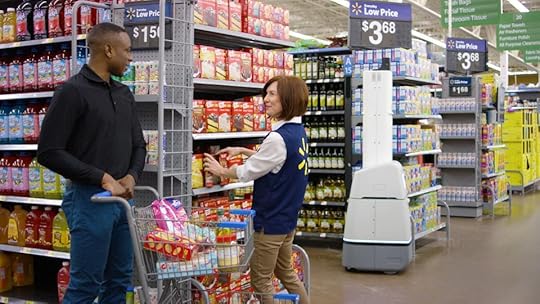Robots Are Taking The Store At Kroger, Walmart And Whole Foods. What Could Go Wrong?
Robots don’t need food, but they do need a recipe for success. This is especially the case when they’re added to the supermarket aisle.
 Photo courtesy of Walmart
Photo courtesy of WalmartThe grocery industry is stepping up its investment in shopper-facing
robot technology ambitiously, and evidently with much confidence, as it strives
to offset the costs of online delivery and pressure from non-supermarket
competition. Retailers overall are investing an estimated $3.6 billion in
artificial technology globally, and are expected to invest $12 billion by 2023,
according to Juniper
Research.
And while a lot of this spending is dedicated toward
warehouse and fulfillment tasks, supermarkets are increasingly earmarking some
of their robot investments for in-store services.
Kroger, in addition to building 20
robot-automated warehouses in the U.S., is testing driverless robot
delivery cars.
Walmart has adapted robots to scan
and sort inventory and identify shelf items that are out of stock. And at 172
Giant Food Stores in the MidAtlantic region, as well as 100 Stop & Shop
stores in New England, a pillar-shaped robot named Marty scopes the aisles for
hazards such as spills and runs price checks.
The evident goal, in addition to cutting costs, is to improve
the in-store and online shopper experience. Robot artificial intelligence can
use algorithms to recall shopper preferences, quickly cross-reference
shelf-prices and they can work around the clock.
What could go wrong? A few things, experience has shown.
Uh-Oh: 3 Robot Fails
Let’s preface these robot fails with the fact that people
tend to hold robots to pretty high standards. A study at the University of
Wisconsin concluded that students were more willing to tolerate the poor
scheduling predictions of humans than of robots. As one
report described it: “It is almost as if people ‘forgave’ the human advisor for
making a mistake but did not extend the same feelings of forgiveness to the
computer.”
Let’s
remember, robots are only human-made. Still:
They creep out shoppers. In Scotland, shoppers were so turned off by a robot named Fabio they wouldn’t even take free meat from it. First the question-answering robot frustrated and spooked shoppers in the aisles (background noises prevented It from understanding queries). So grocery chain Margiotta stuck Fabio in a corner to give away free samples of shredded meat, and shoppers avoided that aisle all together. The experiment was, well, scotched. Indeed, 95% of consumers said they don’t want to talk to a robot or chatbot while shopping in-store or online, according to a by Oracle NetSuite. They don’t always save (the right) face. A New York teenager sued Apple this spring after it incorrectly identified him as a shoplifter. The actual thief had stolen the teen’s driver permit, which did not include a photo, and used it as identification in the stores. The suit claims Apple’s facial recognition system linked the face of the camera-tracked shoplifter, who hit several stores in multiple states, with that of the teen. The boy was arrested, but after detectives reviewed the surveillance footage, they realized they had the wrong guy. They could take your job. The cost savings realized through robots come, in part, through job efficiency (read: more work; fewer hours). However, the jobs won’t fully disappear, said Ben Wald, cofounder of Very, an Internet of things software development and design firm. “In the AI-dominated world, employees who were once drivers, stockers or cashiers can be retrained to operate and maintain the devices and programs needed for food production, delivery and sales,” he said in an email. The unanswered question is whether they will be better-paying jobs.
Bot Around The Clock: 3 Benefits
If robots do save money, it will ideally be used to
improve supermarket experience and operations. Here are ways how:
They can get the price right. Robots can use their high-paced monitoring
capabilities to scan and gauge price tags and check accuracy. Stop & Shop’s
googly-eye
robot, Marty, for
example, could recognize if a price tag has
fallen from a display of cereal. It will then snap a photo of the product,
forward it to an employee at the company TaskUs, which operates the system from
hundreds of miles away, to confirm the problem. Marty then alerts customers and
store employees.They’ll show you the way. Product location is a big issue for big box
stores, such as Lowe’s. A lot of shoppers, fearful of getting sucked into a
search vortex, will go to a smaller store or give up on items on their list.
Lowe’s is testing an in-store robot, LoweBot, to help
shoppers locate items
in the store and to perform other robot tasks, such as track inventory in real
time. In 2018, Lowe’s added a text-based customer service platform to
anticipate customer needs.They will do the grunt work, without
complaint. Robots not
only can work around the clock; their AI technology could automate the
least-appealing parts of work, such as cleaning. Walmart is deploying
autonomous floor scrubbers at 1,500 locations. As it described
in a statement to National Public Radio in April: “The tasks being automated are generally things
that we struggle to find, hire and retain associates to do. As we’ve started
changing the job to take out some of that routine work, it’s becoming easier to
find people to do those jobs.”
And robots don’t need lunch breaks. However, while robots don’t eat food, they do feed on data to perform accurately. In return they could serve the shopper more effective, enjoyable and seamless experiences. The recipe for that success is in determining the right, experience-enhancing reasons to release the robots at the start.
This article originally appeared in Forbes . Follow me on Facebook and Twitter for more on retail, loyalty and the customer experience.
Bryan Pearson's Blog
- Bryan Pearson's profile
- 4 followers



